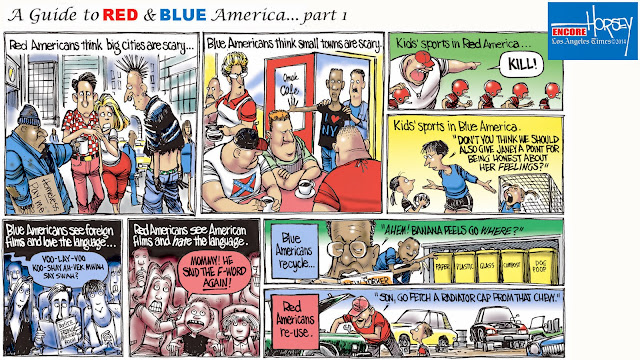American Political Culture is Conflictual
When it comes time to vote for the president of the United States, arguably one of the most influential and powerful person every four years, we see our states divide into two groups: "Red" and "Blue" states. These two bodies of American political ideology clash against each other on political issues that are ongoing because of opposing beliefs and values. |
| Map of the United States by Electoral Weight from 2004 (Cartogram) |

These differences in lifestyles might show in economic issues and debate because of self-image. In Red America, "they work so hard that they've got to keep their arm muscles unencumbered and their armpit hair fully ventilated, so they either buy their shirts sleeveless or rip the sleeves off their T-shirts first thing.." and in Blue America "it is full of upper-middle-class towns inhabited by lawyers, doctors, stockbrokers,and establishment journalists." This shows how the red-staters work hard and usually physical work while the blue-staters show a sense of superiority with their corporate jobs and sophisticated lifestyles.
Another big part of people's lives is religion. Red America is seen as traditional and religious while Blue America is seen as modern and secular. This can affect electoral votes because of beliefs on some issues, such as homosexuality and abortion. Out of the 42 percent of the electorate that attend religious services weekly, 59 percent voted for Bush, 39 percent for Gore and out of another 42 percent of the electorate that seldom or never attends religious services, 56 percent voted for Gore and 39 percent for Bush.
In the video, "Crossfire: The great divide- red vs. blue states (part 1/3," Governors Rick Perry(Texas) and Pat Quinn(Illinois) debate about the minimum wage. Governor Quinn believes that the minimum wage should be raised in Texas like it is in Illinois ($8.25) because he believes anybody working hard and is raising a family should not be in poverty. He believes that anybody with a job should be making enough to live. Newt Gingrich, former speaker of the House of Rep. says that "states that have raised the minimum wage actually have the worst unemployment rate." Governor Rick Perry also believes that raising the minimum wage should not be the government's job and that it will cause many jobs to be lost. This shows the difference in the Red and Blue states' beliefs. The Democratic state believes that to help the people, the government should get involved in their lives by increasing minimum wage while the Republicans believe that the government has no business in changing the minimum wage and it should stay the same.
The Facts on Raising the Minimum Wage When Unemployment Is High
There Are Many Ways to Map Election Results. We’ve Tried Most of Them.
Content and Creativity = 4
ReplyDeleteVoice = 4
Text layout & Use of graphics/multimedia = 3
Quality of Writing & Proofreading = 3
Timeliness = 4
Total = 18